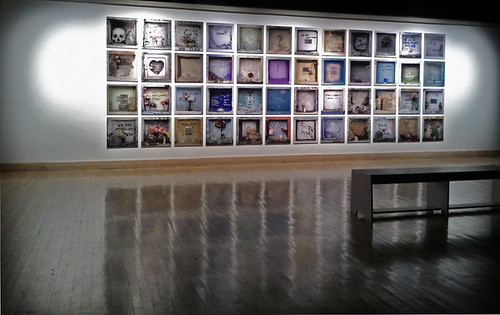Sunday, October 02, 2011
After Echavarria
Went to the MAI (Montreal Arts Interculturels) gallery space today to see Juan Manuel Echavarria’s “Requiems”, the photo and video exhibit that had inspired much of our work on Nohayquiensepa. I had only seen it online - never in person - before. Seeing it now really makes me think about what a photo exhibit can say vs theatre.
Briefly: the exhibit is a visual recreation of a section of the mausoleum in Puerto Berrio, Colombia, a port town on the Magdalena river, where many unidentified body parts wash up (a sad result of the civil conflict) and are interred pending identification. On these graves the coroner marks a tracking number, and ’NN’, meaning ’no nombre’: no name. Seeing these as souls lost to the families who might pray for them, locals come in and ’adopt’ them: praying for them, tending their mausoleum plots, and offering them water because lost souls get thirsty. In return, the living ask the dead for favors.
The exhibit had a surreal quality to it for me. Bea and I went to Puerto Berrio ourselves in 2011 to visit the cemetery and interview the groundskeeper. He told us that NN’s were placed in various areas as space allowed, and that the ’NN section’ (of Echavarria's exhibit) was in fact the area dedicated to children. What often happens is that the parents of many children, either from grief or poverty, stop coming to do upkeep on their children’s graves, which, unpaid for, fall into disrepair. Many of these squares would be claimed in the night by people looking for good luck, who quickly paint over them, and adopt them as NNs.
So when I go back to the source material that gave us our start on a visual vocabulary for our show, I am deeply aware of what we tried to uncover and how we presented it to an audience. I don’t believe that Echavarria was hiding part of the story, but I do think there are gaps in what he knew. So do I. What intrigues me is where he stopped asking questions: at a point where the beauty of a kind of tribute brought the story to a satisfying close. He pointed out a terrible situation, and the consequent human reaction to it, which made me want to cry and make art. But he did not, for instance, introduce the sports fan who adopted an NN, in a kind of spiritual contract, to get supernatural blessings for his team.
His photography showed us a moment of human empathy, a tribute to the spirit of hope.
So in contrast, I ask myself: what did our play show?
We created situations. I know their limits: part of me wanted to shout raw condemnations at transnational firms implicated in a number of practices that would expose them to criminal penalties and lawsuits if they happened in Canada. But that kind of polemical politics was not the place, emotionally, that we wanted to occupy. So we held on to some ambiguity towards "who did what" in the tragedy of Puerto Berrio, and instead focused on the people affected by these violent events: locals, victims of violence, the displaced, and even the ’company men’ dealing with the aftermath. Through them we tried to recover a sense of how life and death are balanced out in Colombia and here at home in Canada.
So in some way I have done exactly what Echavarria did: I told only part of a story. I suppose that is what all of us do. The fact of telling a story, through any medium, requires a beginning and an end: these do not truly exist in our lived history, where tomorrow and yesterday always leave a mark. But hopefully I held to the truth of the situations as I found them, and did not alter that truth, in the midst of our abstract reportage, by omission.
Of course I know that ultimately I will fail at this, but that is a truth so common as to be nearly meaningless.
